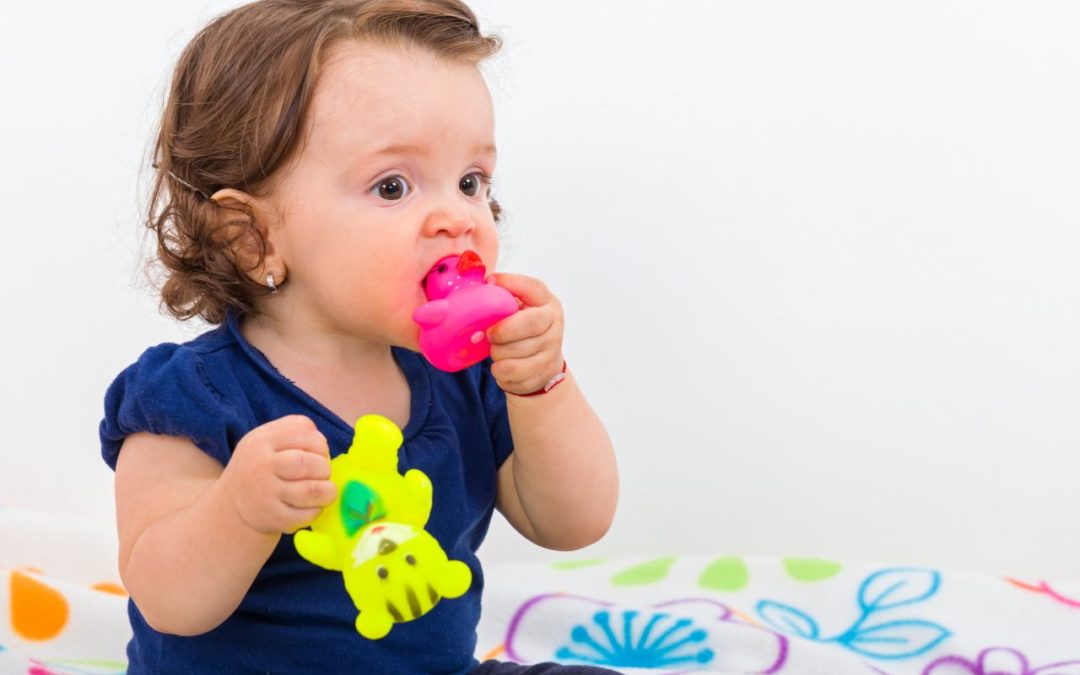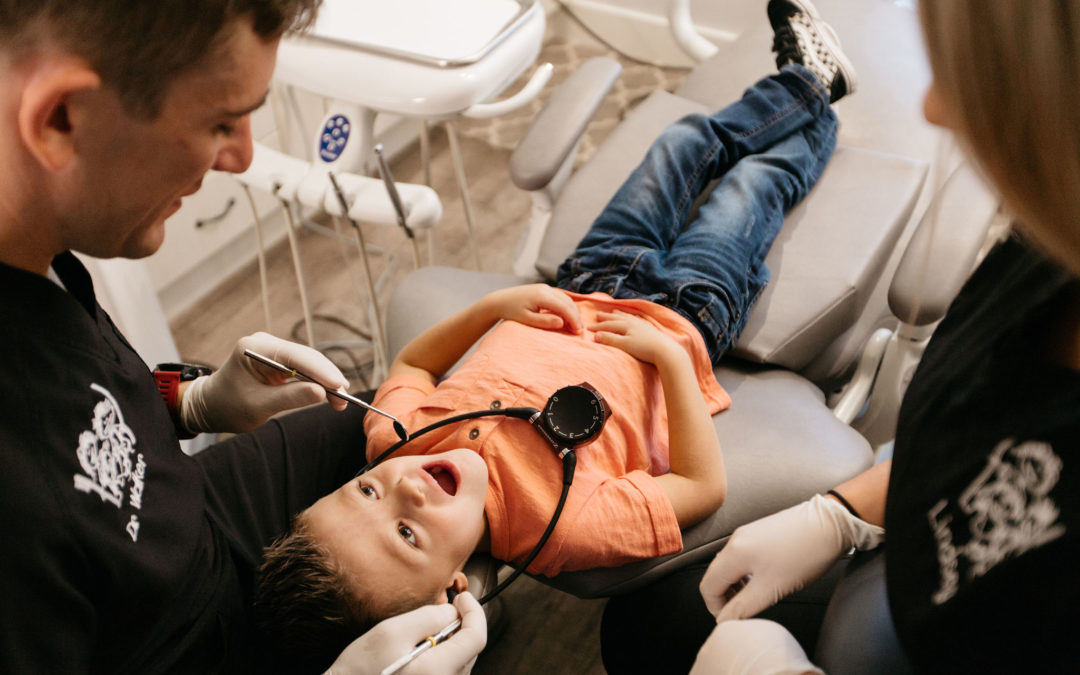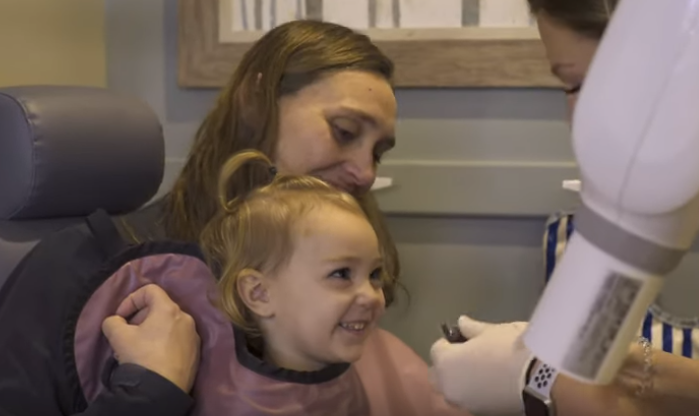
by databot | Mar 25, 2020 | Children's Oral Health, Pediatric Dental Treatments
Any parent or guardian with kids, remembers the scary toddler phase where everything in reach is on their non-discerning mental list of things to chew on. The phase when they pick up everything, and to learn about it, they pop it into their mouth. Little toys, scraps of forgotten food that fell off the table at mealtime, a rubber band. Anything. We all breathe easier when that phase passes. And yet, as our kids get older, some of them continue chewing on things. You might catch them chewing on a pencil, or a pen. Biting nails is a common occurrence, and crunching ice also seems popular. Maybe the neckline or cuff of their shirtsleeve seems to be irresistible. That last one can really have parents wondering, “what causes a child to chew on clothes?”
Why Do They Chew on Stuff?
There are a variety of reasons behind kids chewing on non-food things, some reasons include:
Anxiety or stress – the act of chewing as a soothing activity goes back to the days of being a baby when sucking was an act to self soothe.
Sensory needs – chewing is relatively common as a soothing activity for children with sensory issues.
Concentration – the repetition of chewing can help focus and block outside distractions
Habit – chewing can be a habit born of boredom and convenience because there is always something available to chew on (pencils, clothing, hair, etc.)
Is Chewing Bad?
The act of chewing is not in and of itself a bad thing. Chewing stimulates the flow of saliva in your mouth. Saliva is the frontline defense in your mouth against tooth decay and plaque. According to the American Dental Hygienists’ Association (ADHA), “Saliva contains important elements such as bicarbonate, calcium, and phosphate. They not only neutralize plaque acids, but also help repair early tooth damage and decay.”
Problems come into play with chewing when the object being chewed is a non-food item. We then can become concerned for safety (choking hazards), concerned for what is socially acceptable (wet shirt sleeves or torn bloody fingernails), and concerned for the health of their teeth (cracked or chipped tooth or a loose dental filling).
Does Ice Count as a Non-Food Item?
Chewing ice is a common habit among kids, teens, and adults. And it is unequivocally, a bad habit. Ice is very hard and possesses the ability to crack or chip your teeth. Our composite fillings that we use on teeth that have cavities can have lifespans of up to ten years or more when properly cared for, but are vulnerable to damage caused from habitually chewing ice. It is painful to lose a filling and usually means an immediate trip to the dentist for replacement. Additionally, any brackets or retainer wires can be dislodged from teeth and damaged by chewing ice. We don’t want that for your kid any more than you do.
How Should You Respond When You See Your Child Chewing Non-Food Items or Ice?
Keep in mind that their chewing habit may not be a conscious one. Do they do it when they seem nervous or stressed? Do they have other sensory issues? Try to point out the habit without judgment and resist any inclination to shame them from doing it. Shaming the habit could lead them to hide it from you but continue the behavior or do it as a form of rebellion. If you believe it to be a sensory issue, consult with their pediatrician. If it is a soothing technique for stress or anxiety, consider talking to them about other coping techniques or consult their pediatrician or school guidance counselor. Provide your child with age appropriate information about the dangers of chewing on non-food items and ice.
Is Chewing Gum Bad?
Chewing gum can be good for your child’s dental hygiene after meals. There are, however, qualifiers. Firstly, if your child has braces or a retainer or TMJ disorder, then chewing gum is a bad idea. The gum will stick to the hardware and be not only a pain to get cleaned but can damage the wires or brackets. For kids with TMJ disorder, chewing gum can cause more frequent headaches and jaw pain. Secondly, the gum must be sugarless.
According to the American Dental Association (ADA), “Research shows that chewing sugarless gum for 20 minutes following meals can help prevent tooth decay. That is because the act of chewing increases the flow of saliva in your mouth, which helps neutralize and wash away cavity-causing acids and bacteria. Over time, acids can wear away tooth enamel, creating ideal conditions for decay. Look for chewing gum with the ADA Seal to be sure it can help prevent cavities.”
For Your Kids Who Like to Chew
If you have a kid that likes to chew on things, consider serving up crunchy snacks. Carrot sticks, celery sticks, and crunchy apple slices are healthy snacks that can satisfy the chewing urge. Nuts are also a great snack. Read our blog post Do-Eats and Don’t-Eats for Kids to Promote Healthy Teeth for more ideas about healthy snacks, and to read about why some of those crunchy foods are also good for teeth.
But Wait!
Yes, we are saying chewing sugarless gum can help with dental hygiene but it in no way should be used as a substitute for brushing and flossing! Morning and nighttime routines of brushing for two minutes and flossing at least once daily are vital to your child having a healthy smile.

by databot | Mar 12, 2020 | Children's Oral Health, Pediatric Dental Treatments
Pediatric patients are special. Unique. It is not the same job to perform dental treatments on people who are grown and able to tolerate sitting for long periods and sometimes undergoing uncomfortable dental work verses, pediatric dental patients.
Children, especially those who are very young or who have special needs, do not have that type of restraint that’s needed to easily sit still and tolerate dental work. From our sedation dentistry services to our TVs in the treatment rooms equipped with headphones and all, we go the extra mile to take the stress out of the dental experience for children.
All our dentists have earned special certification for working with only children. Come visit any of our locations to find the following types of pediatric dental services:
Routine Checkups
We believe that healthy lifelong dental habits start in childhood. In a routine checkup, we conduct examinations of the teeth and gums with gentleness and do cleaning when deemed necessary. We will discuss with you and your child how to properly brush and floss at home and explain it in an age-appropriate way to ensure success. We will make a recommendation on the frequency of checkups needed, tailored specific to each child.
Radiographs
Radiographs are commonly referred to as X-Rays. Radiographs of your children’s’ mouths are just as important as they are for adults. A growing child doesn’t only mean larger shirts, pants, and shoes. It also means a growing and changing mouth. Radiographs are a valuable tool in evaluating tooth health that may not be visible by our eyes alone. We will discuss whether there is a need to perform radiographs with you, based on your child’s unique needs.
Fluoride Varnishes
Fluoride is known to work in strengthening tooth enamel. Tooth enamel is assaulted daily by the sugars and acids in the foods and drinks that we consume. That is why we recommend using a fluoride toothpaste, drinking water that has fluoride, and fluoride varnishes. We can provide this dental treatment two to four times a year, depending on the needs of your child’s teeth. Go here for more information about fluoride varnishes and for a video of our Dr. Jason Horgesheimer as he discusses the benefits of this dental treatment.
Dental Sealants
Our teeth have natural grooves and valleys on their surfaces. These spots are attractive places for sugars and acids to hide from toothbrushes. Dental sealants are a common procedure we perform, and are prevention focused. A sealant is applied to cover these deep groves and valleys to prevent tooth decay in these hard-to-reach places on teeth. They will not be noticeable to anyone because the sealant matches the color of the tooth. The process of application of the sealants is also pain-free.
Mouthguards
Grinding teeth can be a normal part of the process as new molars are preparing to push through in your child’s mouth. If you have concerns let us know. We can assess for damage or wear and tear on the teeth. Typically, only in severe cases do we recommend a mouthguard.
Composite Fillings
Cavities happen despite our best efforts sometimes. When they do, we’re here for you. For small to medium sized cavities, we can repair the tooth, after removing the cavity, with a composite filling. For our composite fillings, we use a composite resins mixture. These resins are a combination of plastics and silica. Our composite fillings are discreet because they will match the color of the tooth.
Pulpotomies
When cavities or tooth decay have been left too long untreated, they may penetrate through the enamel and into the “pulp” of the tooth. This is the part of the tooth where the nerves are clustered. It is not uncommon for cavities in primary teeth to reach the pulp of the tooth, when this happens your child will report a tooth ache. It is important to get in to see us if your child reports a tooth ache, because when a cavity reaches the pulp, the tooth can die if left untreated too long.
The pulpotomy involves making a hole in the enamel of the tooth to remove the infected pulp. A protective cap is then applied to protect whatever healthy pulp remains.
Dental Crowns
In cases where your child’s tooth is more badly damaged than a filling or pulpotomy can repair, we may decide a dental crown is the best dental treatment. A dental crown is a cap that has been formed into the shape of the tooth and placed over the tooth to prevent any further decay or damage to it. We typically recommend a porcelain crown if a front tooth is involved to make it less noticeable. We will often recommend a stainless-steel crown if capping a molar.
Frenectomy
Frenectomies are also called the tongue tie release or lip tie release. The maxillary frenectomy is where a piece of the tissue connecting the upper gums to the front teeth is removed. The Lingual frenectomy is where a piece of the tissue that connects the mouth floor to the underside of the tongue is removed. Frenectomies are often confused with frenotomies. Frenotomies are typically performed on newborn babies in cases of problems with latching for breastfeeding and involve a “snip” of the frenum. For more information on this topic, watch our video here.
Extractions
An extraction may be warranted if a primary tooth cannot fall out as it naturally should due to curved or over long roots. Additionally, extractions may be performed if a tooth is so decayed that it risks spreading the decay to the surrounding teeth.
In-Office Sedation
We take your child’s comfort and dental health seriously and pride ourselves on our ability to provide your children with a positive dental experience. Sometimes, a dental treatment may require in office sedation. Anxiety, or your child’s age may be a factor in determining whether they can cooperate for the treatment required. We offer four different sedation options to meet your child’s needs.
A pediatric specialist must complete an additional two-to-three years of training on top of the thorough training already completed in dental school. Yearly continuing education courses are also a requirement to ensure our specialists are up to date on the techniques and processes involved with sedation dentistry.
You can place your confidence in us because of our experience. We have collectively performed over 25,000 in office sedations in all our time as pediatric dentists serving the Salt Lake City area. In fact, we span far and wide with different locations in Bountiful, Taylorsville, Herriman, and Stansbury Park. Call us to learn more or schedule an appointment at one of these offices.

by Miranda Booher | Oct 1, 2019 | Children's Oral Health, Pediatric Dental Treatments
Reactions to braces vary from child to child. While some kids are excited about getting their braces on and see it as an “initiation” of sorts into teenage years, still others have a lot of anxiety about braces as they worry about how they will look or feel. One thing is for sure, braces for kids are a big milestone and this orthodontic treatment will make a difference that will impact them their entire life.
As a parent of a child who might need them, you probably have your own set of concerns and questions about braces. Join us as we cover everything you need to know about kids and braces.
Why Do Some Kids Need Braces?
There are several different reasons why kids might need braces, including:
- Crooked teeth
- Overlapping teeth
- Overcrowded teeth
- A “bad bite”, which is also known as malocclusion
When there is a difference in the sizes of the top and bottom jaws, it is known as a malocclusion. In cases where the upper jaw is bigger than the lower jaw, this is known as an overbite. In cases where the lower jaw is bigger than the upper jaw, this is known as an underbite.
Losing baby teeth too soon can sometimes cause tooth and jaw problems that warrant braces for correction. Oral fixation habits, such as thumb sucking, can also lead to dental issues in kids. However, for the majority of cases, issues with the teeth and jaws are simply inherited and if you needed braces, it’s likely that your child will also need braces.
Identifying the Need for Braces for Kids
Your pediatric dentist will most likely be the first one to notice any alignment or bite issues during a routine examination, and they will recommend that your child sees an orthodontist. An orthodontist is a dentist who specializes in jaw/teeth alignment problems. The decision as to whether your child definitely needs braces and what devices would work are made by the orthodontist.
Some kids will see the orthodontist when they are six years old, others might not see one until they are 10, and even some won’t see one until their teen years. There is no concrete age at which your child should see an orthodontist. Sometimes even adults go to get orthodontic treatment done. However, many orthodontists recommend that your child has their first visit around age seven because by then issues like overcrowding or uneven bite should be obvious.
It’s important to keep in mind that even if you start the process early, that does not mean that the child will get braces right away. The orthodontist will assess the problems and decide when is the best time to start treatment. Sometimes they need to do things to prepare the teeth for braces, such as having an appliance installed that widens the jaw or removing teeth to create more space in the mouth.
What to Expect at First Orthodontist Visit
During the first orthodontist visit, your child will receive a thorough full mouth examination. They will have your child bite down to look for alignment issues, and ask you if your child has difficulty chewing, swallowing, and if you’ve ever heard clicking or popping sounds coming from the jaw.
At this first visit, there may be X-rays of the mouth and teeth taken in order to see how they are positioned and if there are permanent teeth that still need to come in. The orthodontist may also make a mold (impression) of your child’s teeth. This mold is created by pressing a tray of gooey material into the top and bottom teeth. Once that mold hardens, the result is an exact replica of your child’s teeth which will then be used to determine the best treatment options.
What are the Different Types of Braces?
Through the steady application of pressure on the teeth, braces eventually move the teeth into a straighter position. In most cases, the child will only require braces that consist of brackets, wires, and rubber bands. Brackets attach to the teeth and are connected by a wire and rubber bands. Over time, the wire is tightened in order to slowly line the teeth up properly. Kids enjoy picking out what color to use for the rubber bands. Metal brackets are still commonly used, but there are now options for clear or white ceramic brackets, which is nice because they are a lot less noticeable. There are also braces that go behind the teeth, and those are called lingual braces.
In some cases where only minor alterations are needed, clear removable braces might be used and they are called aligners. As the alignment treatment progresses, new aligners are used to progress the straitening.
Additional devices might also be needed, such as headgear. Headgear is a horseshoe-shaped wire that attaches to the back of the teeth and it provides a greater force to move the teeth. Thankfully, headgear is usually only worn at night.
Frequent visits to the orthodontist spaced out by a few weeks each will be required once the braces are on in order to monitor progress and make any adjustments that are needed. The length of time a child wears braces will depend on how much needs to be fixed, but on average they are worn for about two years. Once the braces are removed, your child will probably need to wear a specially molded retainer. A retainer is either a small hard piece of plastic that has metal wires on it or a thin piece of plastic that is shaped like a mouthguard. Retainers are important because they help prevent the teeth from wandering back to their previous positions.
Should My Child See an Orthodontist?
It’s important that you find a good, reliable orthodontist that you can trust. After all, braces do more than just straighten teeth to make them attractive, they also help to keep your child’s mouth healthy for the rest of their life.
Are you wondering whether or not your child should see an orthodontist? There’s only one way to find out. When your child sees a highly experienced dentist for an examination, not only can they recommend whether orthodontist treatment is advised for your child, but they can also lead you to highly skilled and reputable orthodontists in your local area.
Call us today at (801) 294-8880 to schedule an appointment with one of our experienced pediatric dentists.

by Miranda Booher | Mar 20, 2019 | Uncategorized
Problems latching on. Painful nursing. Colic. Failure to thrive. Many of these problems can be caused by a tongue-tie or lip-tie in a baby. Check out the following video to learn more about the treatment of a tongue-tie or lip-tie at our pediatric dentistry. When it...





Recent Comments